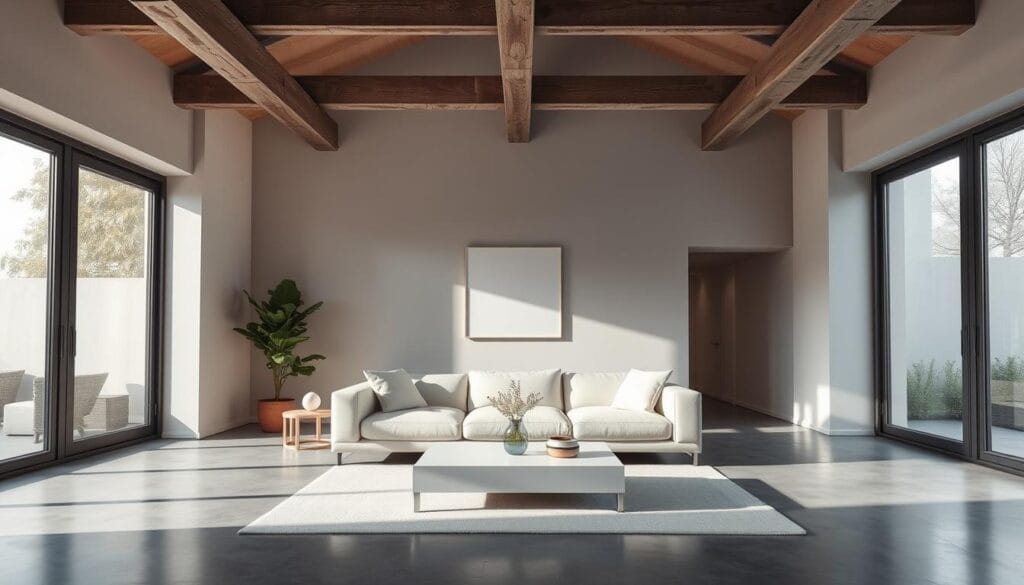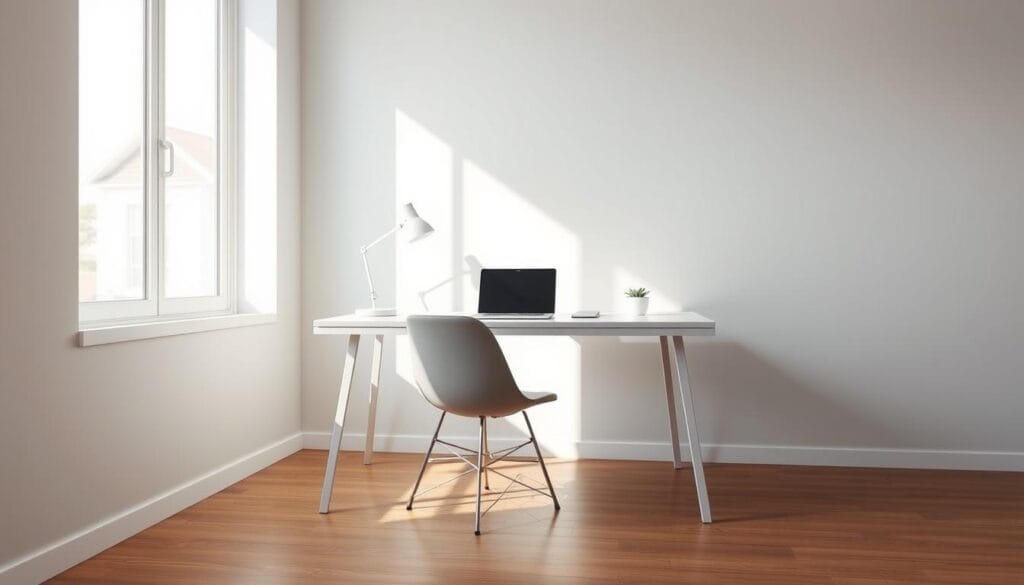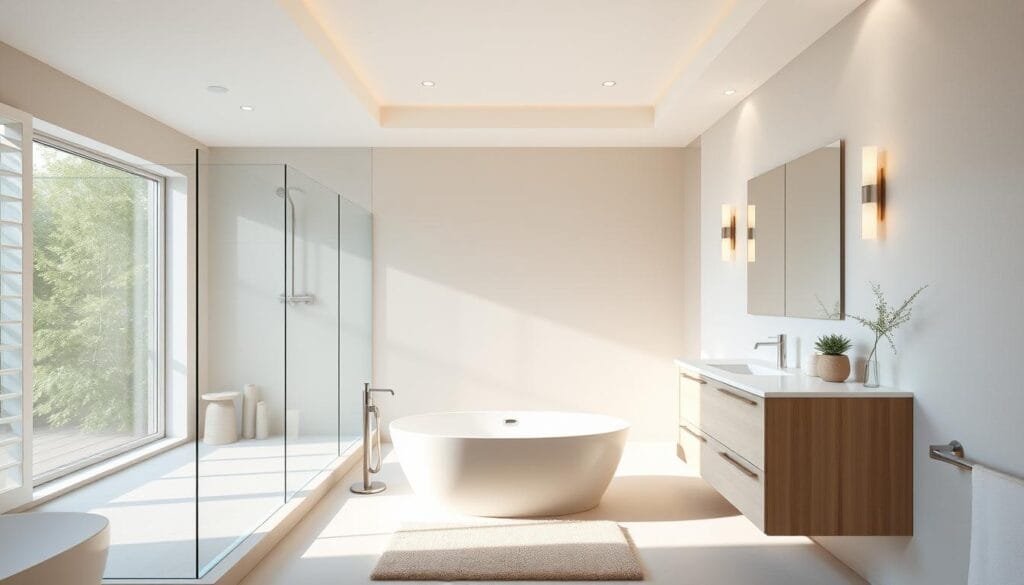Ever walked into a room and instantly felt calm? That’s the magic of modern minimalist spaces. I remember visiting a friend’s place last year. Her living room was a perfect blend of clean lines, neutral tones, and just the right touch of personality. It wasn’t just beautiful—it felt like a breath of fresh air.
This style isn’t just about looks. It’s about creating a space that feels open, functional, and stress-free. By focusing on the essentials, you can transform any room into a serene retreat. Whether you’re starting from scratch or refreshing your current setup, these ideas are designed to inspire.
From choosing the perfect palette to adding thoughtful elements, we’ll guide you step by step. Let’s create a space that not only looks amazing but also feels like home.
Introduction to Minimalist Home Design
Imagine a space where every item has a purpose and a place. That’s the essence of minimalist design. It’s not just about looks—it’s a lifestyle that values simplicity and functionality. By focusing on what truly matters, you can create a calm and inviting environment.
Why is this style so popular among DIY enthusiasts? It’s easy to start and maintain. With neutral colors and uncluttered spaces, your living room can feel more open and functional. Plus, fewer items mean less time spent cleaning and organizing.
Minimalism isn’t just a trend—it’s a sustainable choice. By investing in quality pieces, you reduce waste and create a space that lasts. Think of it as a way to simplify your life while enhancing your room’s aesthetic.
Here’s a quick look at how minimalist design can transform your space:
| Aspect | Benefit |
|---|---|
| Neutral Colors | Creates a calm and cohesive environment |
| Uncluttered Spaces | Enhances functionality and ease of movement |
| Quality Pieces | Reduces waste and adds longevity to your decor |
Simplicity can also make your living area appear larger and more inviting. By removing unnecessary items, you allow the interior to breathe. This approach isn’t new—it’s inspired by decades of minimalism in art and architecture.
“Minimalism is not about deprivation; it’s about intentionality.”
Ready to dive deeper? We’ll guide you step by step to create a space that reflects your style and values. Let’s explore how to bring this timeless design into your home.
What is Minimalist Design and Its Benefits
What if your room could feel both calm and functional at the same time? That’s the magic of minimalist design. It’s about keeping only what you truly need, creating a serene and purposeful space.
At its core, this design philosophy focuses on simplicity. Clean lines, uncluttered surfaces, and a neutral color palette work together to create a peaceful atmosphere. It’s not just about looks—it’s about how your space makes you feel.
One of the biggest benefits is reduced stress. Fewer items mean less visual chaos, helping you feel more relaxed. Maintenance becomes easier too. With fewer things to clean or organize, you’ll have more time to enjoy your room.
Here’s how minimalist design can transform your space:
| Aspect | Benefit |
|---|---|
| Clean Lines | Creates a sense of order and calm |
| Neutral Colors | Enhances a serene and cohesive look |
| Functional Decor | Adds purpose and style without clutter |
Key elements like a single piece of art or a well-placed plant can elevate the look of your space. These thoughtful touches add personality without overwhelming the room.
“Simplicity is the ultimate sophistication.”
By embracing this design, you’ll not only create a beautiful space but also improve your daily life. Ready to explore how to bring these ideas into your home? Let’s dive deeper into the strategies that make it all possible.
The Art of Decluttering for a Simplified Space
Decluttering isn’t just about cleaning—it’s about creating freedom. It’s a creative process that transforms your room into a serene and functional space. By letting go of what you don’t need, you make room for what truly matters.
Start by sorting your belongings into three categories: keep, donate, and discard. Be ruthless with items you haven’t used in the past year. This strategy helps your interior breathe and feel more open.
Simplicity in belongings leads to a more harmonious space. For example, a closet with only your favorite clothes feels lighter and more organized. A kitchen with only essential tools becomes easier to navigate. A living room free from unnecessary items feels calm and inviting.
Here’s how to get started:
- Focus on one area at a time to avoid feeling overwhelmed.
- Use the one-in, one-out rule to prevent clutter from returning.
- Invest in quality storage solutions to keep your decor organized.
The calming feel of a clutter-free space is undeniable. Research shows that decluttering reduces stress and improves mental clarity. A curated collection of items ensures each piece has purpose and meaning.
“Simplicity is the ultimate sophistication.”
Clean lines and thoughtful elements elevate the simplicity of your design. By embracing this process, you’ll not only transform your room but also your daily life. Ready to take the first step toward minimalist living? Start today and experience the freedom of a simplified space.
Embracing White Space and Neutral Palettes
White space isn’t empty—it’s full of potential. In minimalist design, it creates a sense of calm and acts as a blank canvas for your favorite elements. When paired with a neutral color palette, it transforms any room into a serene retreat.
Neutral tones like white, gray, and beige set the tone for a peaceful interior. They allow other features, like light and wood accents, to shine. These touches bring warmth without overwhelming the design.
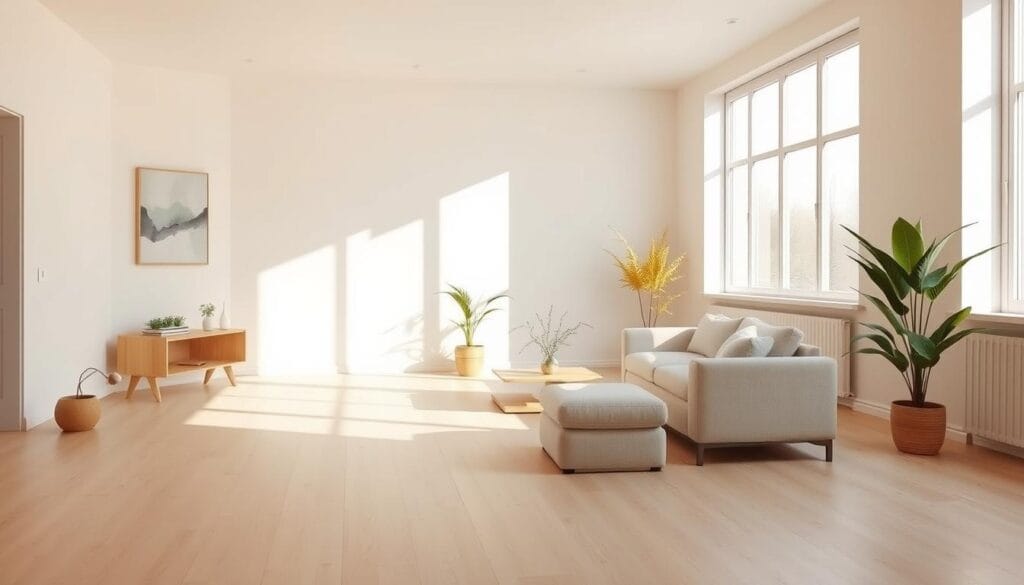
Texture plays a key role too. A cozy rug or a woven throw can add depth to your space. These small details enhance the feel of the room without cluttering it.
Here’s how to integrate these ideas:
- Start with a neutral color base for walls and large furniture.
- Use light to highlight open areas and create an airy look.
- Add wood accents for warmth and natural charm.
- Incorporate texture through soft fabrics or subtle patterns.
Less truly is more. By focusing on these elements, you’ll create a space that feels calm and inviting. Experiment with different combinations to find what works best for you.
“Neutral palettes are the foundation of timeless design.”
Whether it’s a living area or a bedroom, this approach works for any budget. Embrace white space and neutral tones to craft a design that feels both fresh and timeless.
18 Minimalist Home Design Ideas
Ever wondered how a few simple changes can transform your space? From streamlining furniture to incorporating unique art, these ideas are stepping stones to a chic and functional room. Let’s dive into practical tips that work for any style and budget.
Start by focusing on clean lines and functional pieces. A sleek table or a single statement art piece can redefine your decor. These elements add personality without overwhelming the space.
Here’s a curated list of 18 creative ideas to inspire your design journey:
- Streamline your furniture to create open, breathable areas.
- Choose a table that doubles as storage to maximize functionality.
- Incorporate a single bold art piece as a focal point.
- Use neutral tones to create a cohesive and calming space.
- Opt for multifunctional pieces like a sofa bed or nesting tables.
- Add texture with a cozy rug or woven throw for depth.
- Declutter surfaces to highlight key elements like a vase or lamp.
- Use open shelving to display a curated collection of items.
- Repurpose items you already own for a sustainable touch.
- Incorporate greenery to bring life and warmth to your room.
- Choose lighting fixtures that blend form and function.
- Experiment with a single accent wall for a dramatic effect.
- Use glass jars or baskets for stylish and practical storage.
- Keep decor minimal but meaningful with personal touches.
- Opt for a platform bed to create a sleek and modern look.
- Use wall-mounted furniture to free up floor space.
- Incorporate natural materials like wood or stone for warmth.
- Let natural light enhance the airy feel of your space.
Each idea is a building block for a more organized and inviting room. Whether you’re working with a large area or a cozy corner, these tips can be tailored to fit your needs.
“Simplicity is the ultimate sophistication.”
Ready to experiment? Start with one idea and see how it transforms your space. Small changes can lead to big results, creating a room that feels both functional and inspiring.
Investing in Quality and Multifunctional Furniture
Your furniture choices can redefine how you live and work. In a minimalist living room, every piece should serve a purpose. Investing in fewer, high-quality items not only saves space but also enhances functionality. It’s about making smart choices that last.
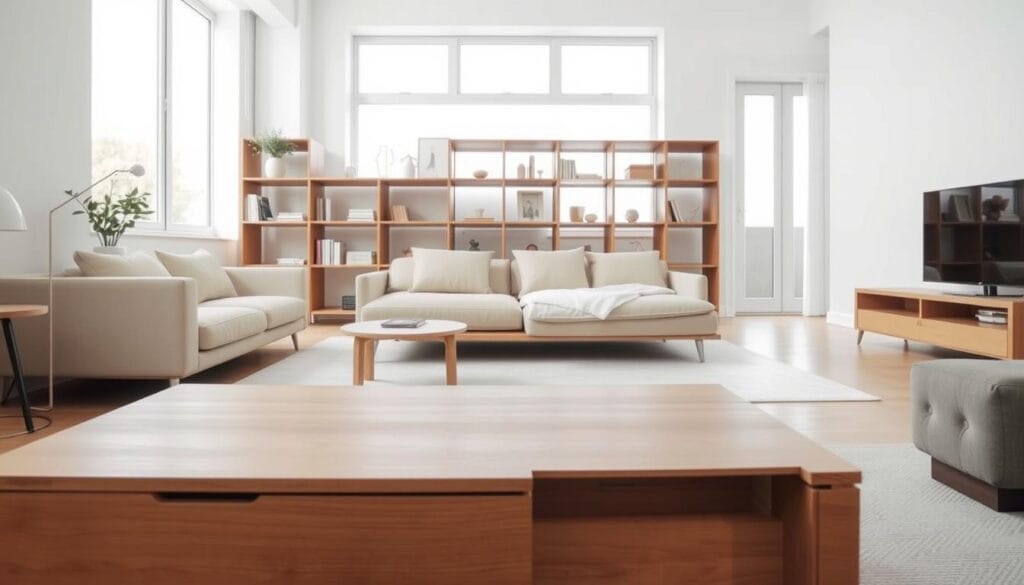
Key Furniture Pieces to Consider
Start with a sofa that combines comfort and style. A sleek, durable piece can anchor your living room. Pair it with a table that doubles as storage or a workspace. These design elements ensure your space feels open and organized.
Here are some essentials to elevate your interior design:
- A sofa bed for overnight guests.
- A dining table that transforms into a desk.
- Storage ottomans for hidden organization.
Multi-functional Solutions for Small Spaces
Small spaces demand creativity. A sofa with built-in storage or a wall-mounted table can maximize your area. These design solutions blend form and function, making your living room both stylish and practical.
For example, a coffee table with drawers keeps clutter at bay. A modular sofa can be rearranged to fit different needs. These pieces are not just furniture—they’re tools for better living.
“Invest in pieces that work as hard as you do.”
Looking for inspiration? Explore multipurpose furniture that combines elegance and efficiency. Thoughtful investments create a lasting impact, turning your space into a haven of simplicity and style.
Innovative Storage and Organization Ideas
Smart storage solutions can transform how you use your space. By integrating clever design elements, you can keep clutter out of sight while maintaining a sleek and functional room. Let’s explore some creative ways to maximize your space without sacrificing style.
Hidden Storage Techniques
One of the best ways to maintain a clean interior is through hidden storage. Ottomans with compartments, under-bed drawers, and lift-top coffee tables are perfect examples. These pieces blend seamlessly into your decor while offering practical solutions for everyday items.
Here are some hidden storage ideas to try:
- Use a storage bench in your entryway for shoes and bags.
- Install concealed cabinets in your living room for media equipment.
- Opt for a bed frame with built-in drawers for extra linens.
Smart Shelving and Multi-Use Tables
Shelving doesn’t have to be boring. Open shelves can display a curated collection of items, while wall-mounted units save floor space. Multi-use tables, like those with built-in storage or foldable designs, are ideal for small areas.
Consider these tips for smart shelving:
- Use ladder-style shelves to add vertical storage without crowding the room.
- Group same-size items on open shelves for a cohesive look.
- Incorporate a mix of cabinets and open shelves for versatility.
Organization Tips for Every Room
Effective storage is key to a minimalist design. Start by decluttering and assigning a place for everything. Use labels to keep items organized and accessible. Here’s a quick guide to organizing different areas:
| Room | Storage Solution |
|---|---|
| Living Room | Concealed cabinets, storage ottomans |
| Bedroom | Under-bed drawers, wall-mounted shelves |
| Bathroom | Stackable bins, behind-the-door organizers |
| Kitchen | Pull-out pantry, tiered spice racks |
Small changes can make a big impact. By choosing storage solutions that complement your design, you’ll create a space that’s both beautiful and functional.
“Good design is as little design as possible.”
Maximizing Natural Light and Streamlined Window Treatments
Natural light has a way of transforming any space into a warm and welcoming haven. It doesn’t just brighten a room—it enhances the overall design, making it feel open and inviting. By focusing on how light enters your interior, you can create a serene and functional environment.
Streamlined window treatments play a key role in this process. They allow light to filter in while maintaining privacy and style. Whether it’s sheer curtains or modern blinds, the right choice can elevate your living room or bedroom.
Choosing the Right Window Treatments
When selecting window treatments, consider both function and aesthetics. Sheer fabrics let in the most light, while heavier drapes offer more privacy. For a modern touch, try minimalist blinds or shades that blend seamlessly with your interior.
Here’s a quick guide to help you decide:
| Treatment | Best For |
|---|---|
| Sheer Curtains | Maximizing light in sunny rooms |
| Blinds | Adjustable light control |
| Shades | Clean, streamlined look |
| Drapes | Adding warmth and texture |
Techniques to Enhance Natural Light
There are simple ways to make the most of the light you have. Use mirrors to reflect light deeper into the room. Opt for lighter color walls and furniture to amplify brightness. Even the placement of your art can help bounce light around the space.
Professional designers often recommend these tips:
- Position mirrors across from windows to double the light.
- Choose light-filtering treatments for a soft, airy feel.
- Keep furniture low to avoid blocking light.
“Natural light is the most underrated element in design. It can completely change how a space feels.”
By prioritizing light, you’ll create a room that feels both functional and inspiring. Start with small changes and see how they transform your interior.
Incorporating Texture, Art, and Statement Pieces
Have you ever noticed how a single texture or artwork can transform a space? In minimalist design, these elements play a crucial role in adding personality without overwhelming the room. By carefully balancing texture, art, and statement pieces, you can create a space that feels both curated and inviting.
The Role of Texture in Boosting Visual Interest
Texture is the secret ingredient that adds depth and warmth to a minimalist space. Think of a cozy throw blanket or a woven rug—these small touches bring life to a room without cluttering it. Mixing materials like wood, linen, and metal can create a layered look that feels both soft and structured.
Here’s how to incorporate texture effectively:
- Use a mix of soft fabrics and hard surfaces for balance.
- Add a textured wall accent, like a grasscloth panel, for subtle sophistication.
- Layer rugs or cushions to create depth without overwhelming the design.
Defining a Room with a Statement Art Piece
A single piece of art can become the focal point of your living area. Whether it’s a bold painting or a sculptural installation, this piece should reflect your personality and style. Choose something that resonates with you—it doesn’t have to be large, but it should make an impact.
Tips for selecting the right art:
- Opt for a color palette that complements your interior design.
- Consider the scale—a smaller piece can still stand out if placed thoughtfully.
- Choose art that sparks joy or tells a story, adding meaning to your room.
Balancing Softness and Structure
Curated collections of decor items can add personality while maintaining a minimalist ethos. For example, a small grouping of ceramic vases or a set of framed photographs can create visual interest without clutter. The key is to keep it intentional—every item should have a purpose.
Here’s a quick guide to balancing softness and structure:
| Element | Purpose |
|---|---|
| Textured Throw | Adds warmth and coziness |
| Statement Art | Creates a focal point |
| Curated Collection | Adds personality without clutter |
By combining these elements, you’ll create a room that feels both functional and inspiring. Remember, less is more—each addition should enhance the design without overwhelming it.
“In minimalist design, every detail matters. Choose pieces that speak to you and let them shine.”
Ready to experiment? Start with one texture or piece and see how it transforms your space. Small changes can lead to big results, creating a room that feels both functional and inspiring.
Digital Solutions for a Clutter-Free Media Space
Have you considered how technology can simplify your daily life? In today’s world, digital tools offer a seamless way to reduce physical clutter while maintaining a clean and organized home environment. By embracing these solutions, you can create a clutter-free space that feels both functional and stylish.
One of the easiest ways to start is by shifting to digital media. Replace physical books, DVDs, and CDs with e-readers and streaming services. This not only clears your living area but also makes your favorite content more accessible. Imagine a media room free from stacks of discs or shelves of books—it’s a game-changer for minimalist living.
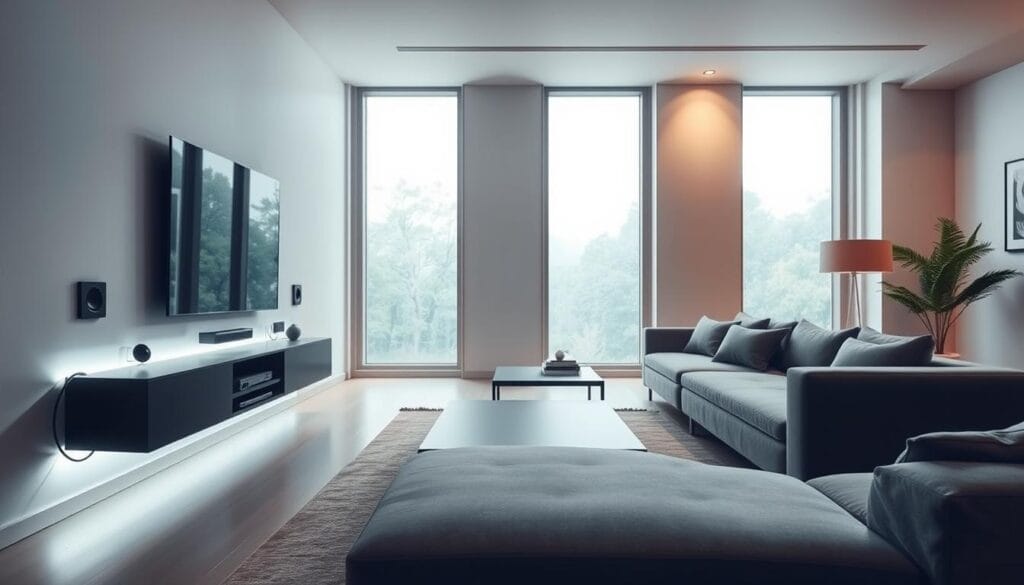
- Use e-readers to store your favorite books without taking up physical space.
- Opt for streaming services to access movies and shows without cluttering your shelves.
- Organize digital files into folders for easy access and a clean desktop.
Technology can also enhance the minimalist aesthetic. Sleek devices like tablets and smart TVs blend seamlessly into your living room setup. Cable management solutions, such as cord organizers or wireless setups, keep your space looking tidy and modern.
“Technology, when used intentionally, can be a powerful tool for simplifying your life.”
By adopting these digital strategies, you’ll not only declutter your home but also create a more efficient and enjoyable living experience. Start small—replace one physical item with a digital alternative and see the difference it makes.
Room-by-Room Guide to Minimalist Interior Design
Transforming your home into a peaceful retreat starts with thoughtful planning. Each room has its own purpose, and applying minimalist principles can enhance both its functionality and beauty. Let’s explore how to adapt these ideas to your living room and bedroom.
Living Room Essentials
Your living room is often the heart of your home. To create a space that’s both inviting and functional, focus on essential furniture and a neutral color palette. A sleek sofa, a simple coffee table, and a few well-chosen decor items can make a big impact.
Here’s a checklist to get started:
- Choose a sofa with clean lines and a neutral tone.
- Opt for a multifunctional coffee table with storage.
- Add a single statement piece of art for visual interest.
- Use soft textures like a cozy throw or a textured rug.
Creating a Serene Bedroom
Your bedroom should be a sanctuary for rest and relaxation. Start by decluttering and keeping only what you need. A low-profile bed, soft lighting, and calming colors can transform your space into a peaceful retreat.
Here’s how to achieve a serene bedroom:
| Element | Purpose |
|---|---|
| Low-Profile Bed | Creates a sense of openness |
| Soft Lighting | Enhances relaxation |
| Neutral Colors | Promotes calmness |
| Minimal Decor | Reduces visual clutter |
Studies show that 70% of individuals feel less stressed in a decluttered environment. By keeping your bedroom simple, you’ll create a space that truly supports rest.
“A calm environment leads to a calm mind. Keep your space simple and intentional.”
Whether it’s your living room or bedroom, these tips can help you create a space that’s both beautiful and functional. Start small, and let simplicity guide your interior design journey.
Warm Minimalism: Integrating Comfort and Style
What makes a space feel both cozy and stylish? It’s all about balance. Warm minimalism blends the clean lines of minimalist design with elements that add warmth and personality. This approach creates an inviting atmosphere without overwhelming the senses.
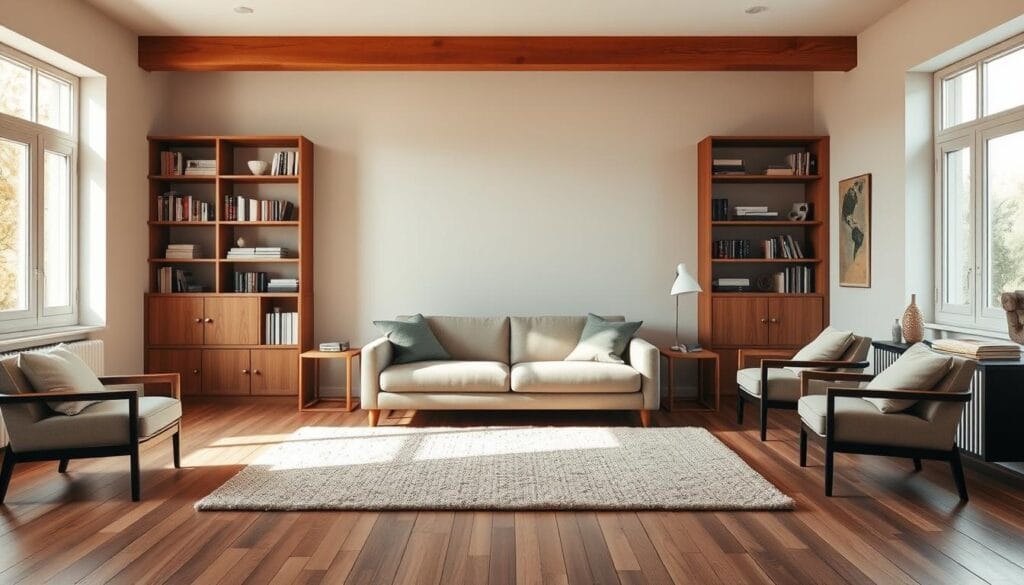
Using Natural Materials for a Cozy Feel
Natural materials like wood are key to achieving this balance. A wooden coffee table or shelving unit adds an organic touch to your living room. These elements bring a sense of calm and connection to nature, making your interior feel grounded and welcoming.
Texture also plays a big role. A rug with a soft weave or a linen throw can make a space feel more inviting. These small touches add depth and warmth without cluttering the design.
Personal Touches That Enhance Warmth
Adding personal touches doesn’t mean sacrificing simplicity. A curated collection of books or a single piece of art can make your room feel uniquely yours. Choose items that bring you joy and reflect your style.
In the kitchen, consider open shelving to display a few favorite dishes or plants. This adds personality while keeping the space functional and uncluttered.
“Warm minimalism is about creating a space that feels both serene and lived-in.”
By combining natural materials, thoughtful textures, and personal touches, you can create a minimalist living space that’s both beautiful and comfortable. Start small and let your interior evolve into a warm and inviting retreat.
Modern Minimalist Trends and Contemporary Touches
What’s the secret to keeping a minimalist space fresh and contemporary? Modern minimalist design embraces both functionality and bold, creative updates. By blending clean lines with current trends, you can create a living room that feels timeless yet modern.
One of the easiest ways to refresh your space is by updating key furniture pieces. A new sofa in a neutral color can instantly transform your room. Pair it with sleek, multifunctional pieces to maintain the minimalist ethos while adding modern flair.
Wall art is another way to infuse personality into your interior. A single statement piece can become the focal point of your living room, adding depth without clutter. Choose art that reflects your style and complements the overall tone of the space.
Here are some fresh ideas to merge clean lines with current trends:
- Incorporate geometric patterns through rugs or cushions for visual interest.
- Use a mix of textures, like wood and linen, to add warmth.
- Experiment with soft color changes, such as muted pastels, to update the tone of your room.
Minimalism continues to evolve with inventive designer insights. For example, floating furniture and modular designs are gaining popularity for their sleek, space-saving appeal. These elements keep your interior functional while staying true to minimalist principles.
“Modern minimalism is about balancing simplicity with personality. Let your space tell your story.”
Ready to experiment? Start with one trend, like updating your sofa or adding a bold piece of wall art. Small changes can make a big impact, creating a space that feels both fresh and timeless. For more inspiration, explore our modern interior design ideas.
Sustainable and Eco-Friendly Minimalist Practices
Have you thought about how your space can reflect your values? Minimalism and sustainability go hand in hand, creating a home that’s not only beautiful but also kind to the planet. By making mindful choices, you can design a room that feels both functional and eco-conscious.
One of the easiest ways to start is by choosing eco-friendly materials. Wood from sustainable sources, like bamboo or reclaimed timber, adds warmth and character to your interior. These materials are durable and reduce the need for new resources, making them a smart choice for any space.
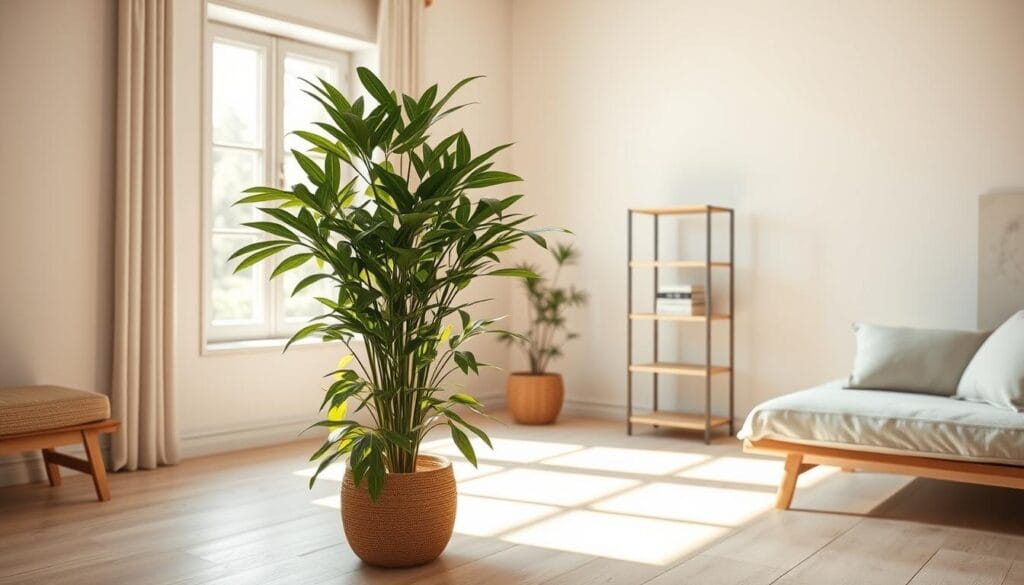
Investing in quality pieces is another key step. Instead of buying disposable furniture, opt for items that last. A well-crafted shelf or a timeless rug not only enhances your living room but also reduces waste over time. Quality over quantity is the mantra of sustainable minimalism.
Here are some actionable tips to make your home greener:
- Switch to LED bulbs, which use up to 80% less energy than traditional ones.
- Choose non-toxic paints to improve indoor air quality.
- Incorporate plants to purify the air and add a natural touch.
- Use reusable items like cloth napkins to cut down on waste.
Energy efficiency is another way to embrace sustainability. Installing solar panels or using natural light can significantly reduce your carbon footprint. Even small changes, like adding larger windows or skylights, can make a big difference in your interior design.
| Material | Benefit |
|---|---|
| Sustainable Wood | Reduces deforestation and adds warmth |
| Recycled Accents | Minimizes waste and adds unique character |
| Organic Textiles | Promotes biodegradable and eco-friendly options |
“Sustainability isn’t a trend—it’s a responsibility. Every choice we make shapes the future of our planet.”
By integrating these practices, you’ll create a space that’s not only stylish but also environmentally friendly. Start small, and let your home reflect your commitment to a greener lifestyle.
Balancing Functionality and Aesthetics in Minimalist Living
How do you create a space that’s both beautiful and practical? The key lies in finding the perfect balance between functionality and aesthetics. In minimalist interior design, every piece must serve a purpose while enhancing the overall feel of the room.
Why is this balance so important? A well-designed space not only looks good but also makes daily life easier. For example, a sleek sofa with hidden storage combines style with practicality. This approach reduces clutter and creates a more inviting living environment.
Designing for Both Form and Function
Start by choosing furniture that works double duty. A table with built-in drawers or a shelf that doubles as a room divider can maximize your space. These elements add value without sacrificing style.
Here’s how to prioritize both design and practicality:
- Select pieces that align with your interior theme while serving a specific purpose.
- Use clean lines and neutral tones to create a cohesive look.
- Let each item “earn its keep” by ensuring it’s both useful and visually appealing.
Studies show that 60% of individuals feel less stressed in a decluttered living environment. By focusing on balance, you’ll create a room that’s both elegant and efficient.
| Strategy | Benefit |
|---|---|
| Multifunctional Furniture | Maximizes space and reduces clutter |
| Neutral Color Palette | Creates a calm and cohesive environment |
| Thoughtful Decor | Adds personality without overwhelming the space |
“Good design is as little design as possible. Every detail should have a purpose.”
With the right approach, you can create a space that truly lives and breathes style. Start small, and let simplicity guide your interior design journey.
Conclusion
Creating a space that feels both functional and inspiring is easier than you think. By focusing on purposeful design, you can transform any room into a serene retreat. Decluttering and thoughtful furniture choices, like a multifunctional table, can elevate your living area.
Natural light plays a key role in enhancing the feel of your home. Pair it with a neutral color palette to create a calm and cohesive environment. These small changes can make a big impact, helping you live more comfortably.
Remember, your style should reflect your personality. Experiment with these ideas to create a space that truly feels like yours. For more inspiration, explore our guide on minimalist interior design.
Start today and craft a home that’s both beautiful and functional. Your ideal haven is just a few thoughtful changes away.

